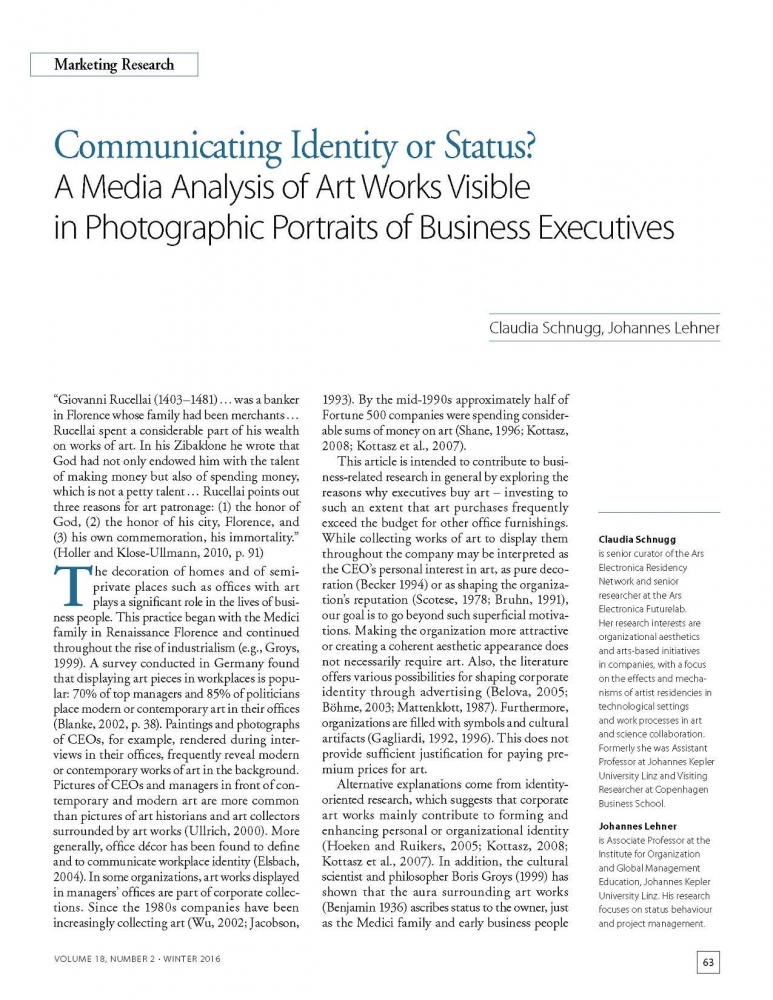Communicating Identity or Status? A Media Analysis of Art Works Visible in Photographic Portraits of Business Executives
Produit: Article
21,00 $ CA
Claudia Schnugg, Johannes Lehner
Claudia Schnugg is senior curator of the Ars Electronica Residency Network and senior researcher at the Ars Electronica Futurelab. Her research interests are organizational aesthetics and arts-based initiatives in companies, with a focus on the effects and mechanisms of artist residencies in technological settings and work processes in art and science collaboration. Formerly she was Assistant Professor at Johannes Kepler University Linz and Visiting Researcher at Copenhagen Business School.
Johannes Lehner is Associate Professor at the Institute for Organization and Global Management Education, Johannes Kepler University Linz. His research focuses on status behaviour and project management.
ABSTRACT
Today, art works appear to be part of the standard furnishings of executive offices. This quantitative study of business magazines in Germany, Austria and the United States found that in approximately 6% of all photographic portraits of executives, the subjects were pictured in front of an art work in their office or boardroom. The authors explore the functions of art surrounding executives in their offices, beyond its decorative component. The literature indicates that corporate art serves to communicate personal or organizational identity. The authors contrast this interpretation with art as a means for executives to resent themselves and promote their social status, art being a form of conspicuous consumption or habitus. The art works are found to have both an identity function and a status function, depending on the type of industry the executive’s organization operates in (production vs. finance) and to a lesser extent depending on the type of organization (single business vs. multi-divisional corporation).
KEYWORDS
Art, art works, social status, identity, visual analysis
RÉSUMÉ
De nos jours, il semble normal que des œuvres artistiques ornementent les bureaux des dirigeants. Cette étude quantitative de magazines économiques d’Allemagne, d’Autriche et des États-Unis illustre que, dans une proportion d’environ 6 p. cent, les portraits photographiques des dirigeants sont captés dans leur bureau ou dans la salle du conseil et affichent une œuvre d’art en arrière-plan. Les auteurs explorent les fonctions des œuvres d’art qui environnent les dirigeants dans leur espace de travail au-delà de leur aspect décoratif. Les écrits montrent que, dans les entreprises, les œuvres d’art servent à communiquer une identité personnelle ou organisationnelle. Les auteurs mettent en parallèle cette interprétation avec la proposition selon laquelle les œuvres d’art permettent aux dirigeants de s’exposer et de promouvoir leur statut social, celles-ci devenant un objet d’une consommation ostentatoire ou mue par des conventions. Les auteurs ont observé que les œuvres d’art servent à la fois à exhiber l’identité et le statut selon le type d’entreprise dans laquelle évolue le dirigeant (production ou finance) et, dans une moindre mesure, selon la structure même de l’entreprise (société individuelle ou à divisions multiples).
MOTS CLÉS
Art, œuvres d’art, statut social, identité, analyse visuelle
RESUMEN
Las obras de arte forman parte hoy día del interior estándar de las oficinas del personal directivo. Según el presente estudio cuantitativo de las revistas de negocios en Alemania, Austria y los Estados Unidos, un seis por ciento de todos los retratos fotográficos de personas en puestos de dirección se han tomado delante de obras de arte que se encuentran en sus oficinas o en las salas de juntas. Los autores exploran el papel que desempeñan las obras de arte en oficinas de la alta dirección, más allá de su función decorativa, y observan que el arte, siendo una forma de consumo ostentoso o un habitus, es una manera para los ejecutivos de presentarse y promover su posición social. Se concluye que las obras de arte poseen a la vez una funcionalidad relacionada con la identidad y la posición, según el tipo de industria (producción o finanzas) en la cual opera la alta dirección, y en menor grado según el tipo de organización (empresa única o corporación con múltiples divisiones).
PALABRAS CLAVE
Arte, obras de arte, posición social, identidad, análisis visual

